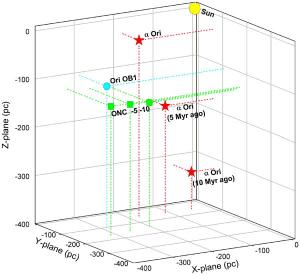Post
Betelgeuse,
Betelgeuse,
Betelgeuse
13 March 2013
In principle, measuring the distance of a nearby star is fairly simple. It uses a method known as parallax. It is the same method we use to have depth perception every day. If you cover one eye and hold your thumb in front of a distant object, when you switch eyes your thumb will appear to shift against the background. This shift is known as a parallax shift, and it is due to a shift in your point of view. The bigger the parallax, the closer an object is.
In astronomy we can use the Earth’s changing position in its orbit to shift our point of view. We can observe a star relative to more distant stars over the course of a year, and measure its parallax. Some simple trigonometry then allows us to determine its distance. Parallax is actually the origin of the word “parsec”, which is short for parallax arc second. If a star has a parallax of one arc second (or 1/ 3,600 of a degree), then it is one parsec away (about 3.26 light years).
For more distant stars, however, this can get a bit tricky. It is particularly difficult for large stars such as red and blue supergiants. Take for example the star Betelgeuse. Betelgeuse is a red supergiant with an apparent size of about 45 milliarcseconds. However its parallax is only about 5 - 10 milliarcseconds. As a result, the distance to Betelgeuse has been relatively uncertain.
This is problematic because without an accurate measure of distance we can’t be sure about other properties. We know the star’s apparent diameter, and its apparent motion, but without a precise distance we can’t be sure of its actual diameter and motion. Knowing those would be useful to determine the age and origin of Betelgeuse.
Recently a team used radio interferometry to make a precise measurement of the parallax of Betelgeuse.1 Radio interferometry allows you to combine signals from multiple radio telescopes to create an image as if they were all one huge telescope. This means you can make much more precise measurements than possible with a single telescope. They determined that Betelgeuse is 197 parsecs away (about 640 light years).
 Harper, et al.
Harper, et al.With an accurate distance the team could then use Betelgeuse’s apparent motion to determine its actual motion through the galaxy. You can see this in the figure (where Betelgeuse is labeled as α Ori). One thing clear from the figure is that the motion of Betelgeuse is very different from the Orion Nebula Cluster (ONC), so it is not likely that Betelgeuse originated in the Orion Nebula. Instead it seems Betelgeuse originated from the Ori OB1 cluster.
Harper, Graham M., Alexander Brown, and Edward F. Guinan. “A new VLA-Hipparcos distance to Betelgeuse and its implications.” The Astronomical Journal 135.4 (2008): 1430. ↩︎